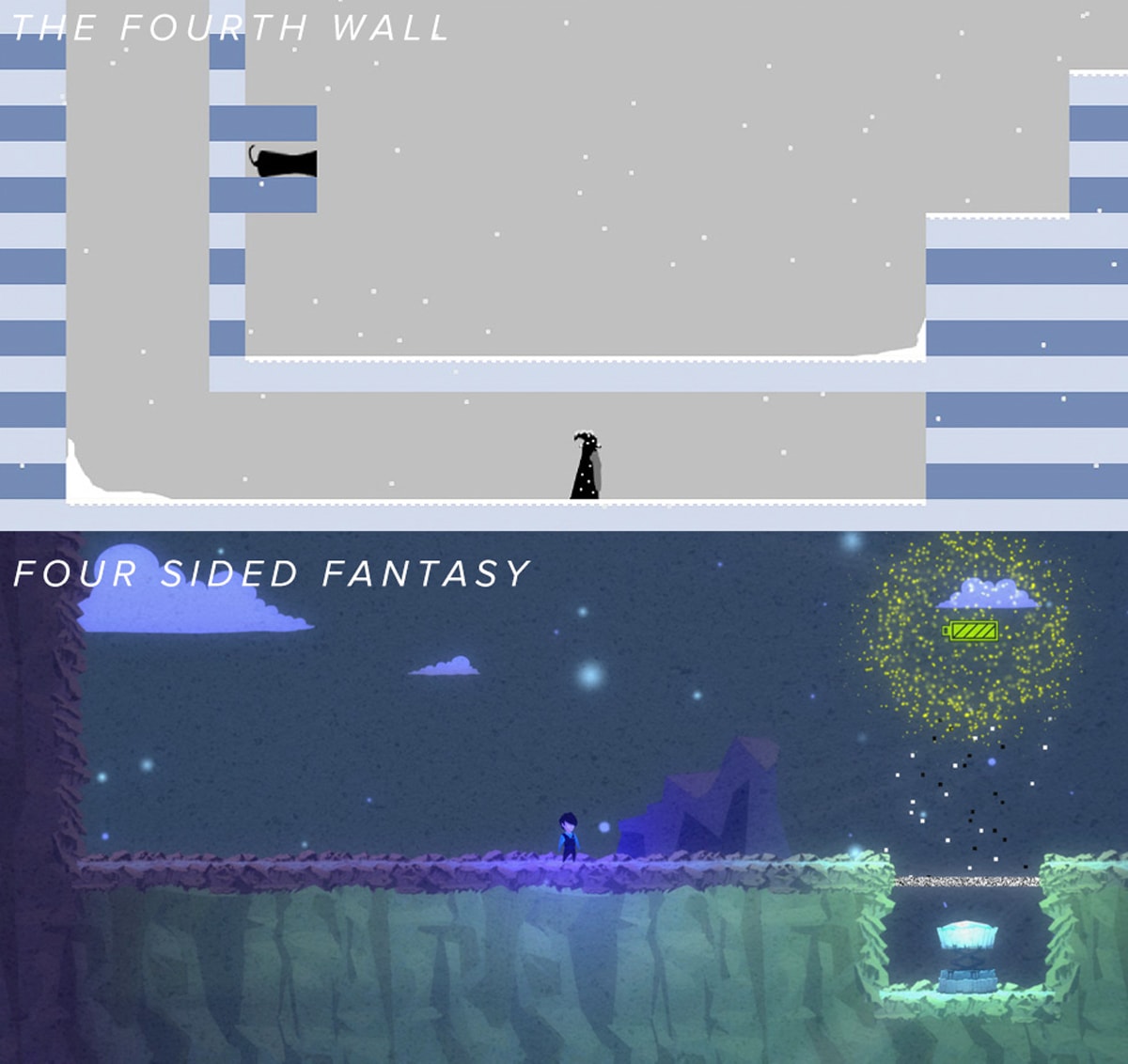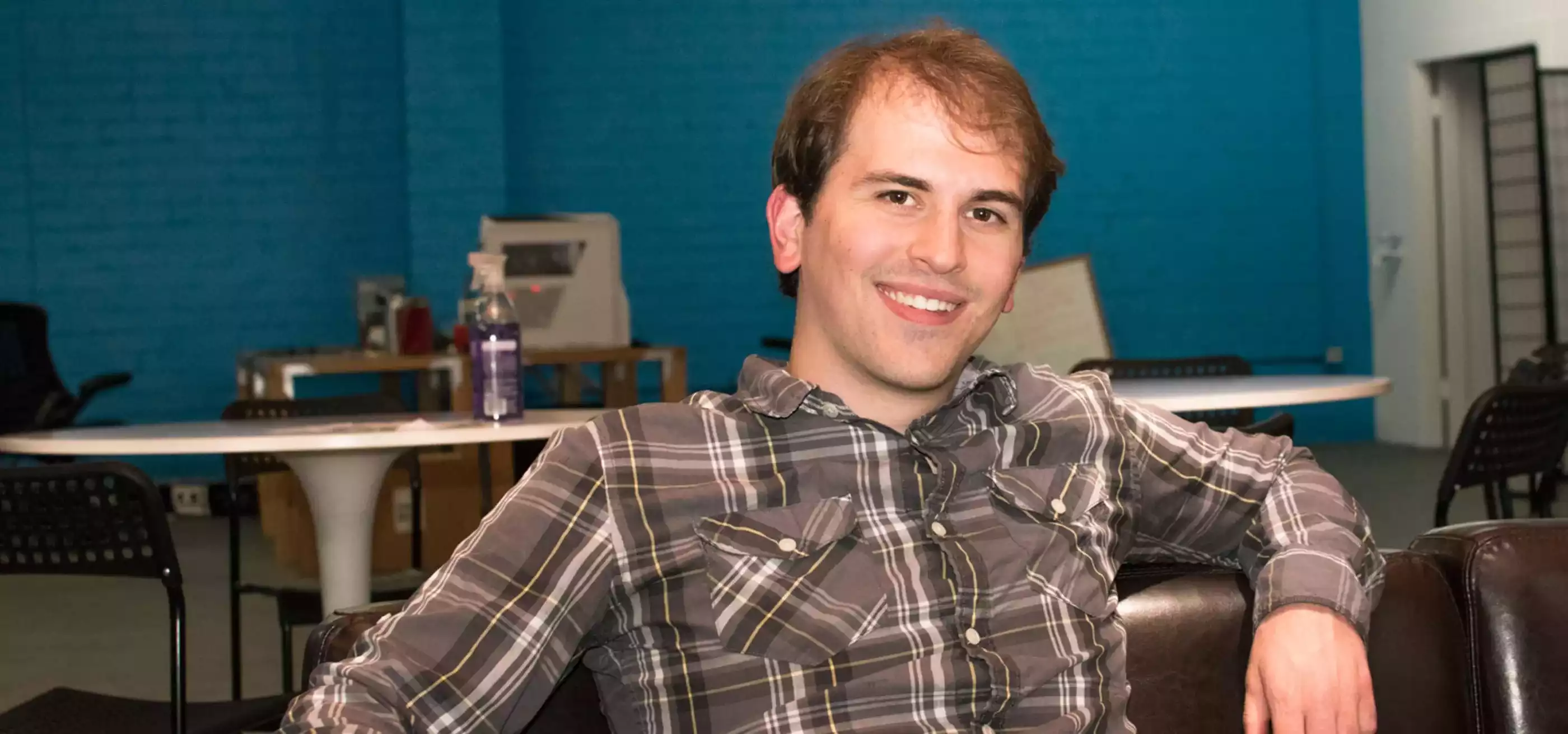For many students at DigiPen, the hope of creating a video game they’ve imagined for years is what drives them to study hard every day and complete high-quality game projects on their march toward graduation. Some graduates go on to work with acclaimed AAA game studios, while others carve their own path through the industry. Logan Fieth, 2013 DigiPen graduate and founder of his own game studio called Ludo Land, belongs to the latter camp, and just a few months ago, he realized his dream when his new game Four Sided Fantasy was released on Steam.
Four Sided Fantasy came out on August 30, two years after Logan successfully funded it with a Kickstarter campaign. The 2D side-scroller game’s unique gameplay centers around a mechanic Logan first explored in his student game project The Fourth Wall, which allows players to “screen-wrap” at will.
“So like in Pac-Man, where you can go off the side of the screen and you’ll ‘wrap around’ to the other side — you have that ability in Four Sided Fantasy, but you can turn it off and on whenever you want,” Logan explains.
Logan initially created the mechanics for The Fourth Wall for a sophomore prototyping class at DigiPen, and from there it ballooned into a full-fledged game project that received critical acclaim for its unique gameplay and mind-bending puzzles.
“With Four Sided Fantasy,” Logan says, “we took [The Fourth Wall’s screen-wrap] mechanic and expanded on it.” Each new level (or “world”) in Four Sided Fantasy alters the screen-wrap mechanic or introduces different rules, keeping players on their toes and providing interesting new puzzles to solve. “For example, there’s a world where gravity flips every time you reach the edge of the screen.”
Whereas in The Fourth Wall the player must navigate a barren world of ice and snow to escape evil forces, the narrative of Four Sided Fantasy follows a woman and man as they traverse a variety of magical lands and fantastical environments. As opposed to fleeing from evil, theirs is a journey of self-realization. Logan says the game’s plot is subtle and centers on the dynamics between the two main characters. “It’s a minimal story told without text or voice-over,” he says. “Basically the different twists on the [screen-wrap] mechanic sort of represent different stages in these two characters’ relationship.” To accomplish the effect he was going for, Logan directed the game’s design to include as few interruptions (such as cutscenes or loading screens) as possible, opting to keep the focus on the gameplay and letting players fill in the blanks.
“One of our goals was to just make the game sort of seamless,” Logan says. “You don’t necessarily have delineated levels — like Level 1, Level 2, or something like that.” Instead, players progress through the story by solving puzzles and navigating diverse environments that gradually blend into one another. “To move from scene to scene we used film-like transitions like foreground wipes and dissolve fades,” he says.
All of this is a major departure from Logan’s student project The Fourth Wall, which had a darker tone and simpler style in terms of both look and plotline. “We completely revamped the art style,” says Logan, who describes the new aesthetic as “serene.” “It’s a much more colorful game than the student project.”
The transition from The Fourth Wall to Four Sided Fantasy didn’t happen overnight — in fact, the long arc of Four Sided Fantasy’s overall development spans over half a decade (Logan and his teammates finished The Fourth Wall in 2011). After graduating from DigiPen’s BA in Game Design program in 2013, Logan joined some of his former classmates at a game studio in Seattle. He soon realized, however, that what he really wanted to do was work on his own projects.
“It was an enjoyable job, but whenever I went home, I’d be toying with this prototype of going back to The Fourth Wall,” Logan says. “Basically that’s what I was thinking about all the time, was this prototype. And I was like, ‘Well, I should probably work on the thing that I’m thinking about all the time, rather than something else.’”
The prototype in question eventually became the core game experience of Four Sided Fantasy. After weighing his options, he quit his job as a level designer to pursue his personal project full-time.

“It was definitely a risk,” Logan says, “but it was one I was willing to take.”
Logan founded his own game studio called Ludo Land in 2013 and launched a Kickstarter campaign to fund Four Sided Fantasy in April of 2014. (“Ludo” is Latin for “I play.”) Thirty days later, on the final day of the Kickstarter campaign, the game met its $35,000 goal and was successfully funded with a total of $37,912 pledged by backers. This was Logan’s first Kickstarter, and he says that the process taught him a lot about marketing a game.
“Looking for funding, I was like, ‘Well, I don’t have any experience with this,’” Logan recalls. “So I didn’t really know what avenue to pursue.” Should he be talking to publishers, turn to crowd-sourcing the game, or developing it without a budget? Deciding how to fund his first project, he says, was tough. “To be honest, looking back on it, I didn’t have any experience with Kickstarter either,” he laughs, “but that’s the direction I chose.”
It was definitely a risk, but it was one I was willing to take.”
In his case, the choice paid off.
“I’m really appreciative of our Kickstarter backers,” Logan says. “Our backers are awesome and super kind.”
Despite being both the creator and showrunner behind Four Sided Fantasy, Logan is quick to point out he didn’t do it all alone. During the Kickstarter, he invited some of his old teammates from DigiPen to join him for the ride. These teammates included artist Amalachi Zacharia and composer M.J. Quigley, whom Logan had worked alongside to create The Fourth Wall and Perspective (another highly regarded student game), respectively, as well as other former students whose skills Logan admired, such as Jesse Phillips.
Jesse, a former DigiPen student who pursued a BFA in Digital Art and Animation, worked with Logan on Four Sided Fantasy as a character animator and environment artist.
One of the challenges of creating art for Four Sided Fantasy, according to Jesse, was ensuring the art elements complemented the gameplay without overwhelming it. “The game is really about the puzzles rather than the actual [look of the] characters themselves,” he says. “So [my goal was] to strike a balance between making the art look nice but not over-embellishing and making it distracting.”
If you just twiddle and mess around with it, you’re not really improving anything if you don’t even know what people think about the game.”
Logan says he drew on many lessons from DigiPen while designing Four Sided Fantasy. “One of the most important things I learned at DigiPen is ‘playtest early and playtest often,’” he says. “There’s a tendency — I think for indie developers especially — to make sure the game is perfect before they show anybody. But what I learned while I was at DigiPen is that it’s never really too early to playtest. If you have something where you can move around and jump around or interact with anything, you can playtest. [But] if you just twiddle and mess around with it, you’re not really improving anything if you don’t even know what people think about the game.”
Logan and his teammates finished development last summer and worked with publisher Serenity Forge to put Four Sided Fantasy on Valve’s Steam platform. Since their August 30 launch, Logan has been busy promoting the game, getting player feedback, and pursuing new game projects. He’s excited about the future of Ludo Land and players’ reception of Four Sided Fantasy. The game has received positive reviews on Steam, with an average player review score of 8/10 as of November 2016.
The Four Sided Fantasy team is made up of the following DigiPen alumni and former students:
Logan Fieth (2013, BA in Game Design)
Jesse Phillips (BFA in Digital Art and Animation)
M.J. Quigley (BFA in Digital Art and Animation)
David Scamehorn (2014, BA in Game Design)
Ian Shores (current student, BA in Music and Sound Design)
Jason Wang (BFA in Digital Art and Animation)
Amalachi Zacharia (2014, BFA in Digital Art and Animation)
